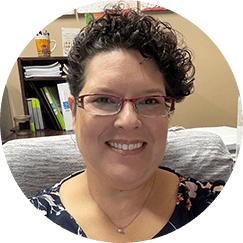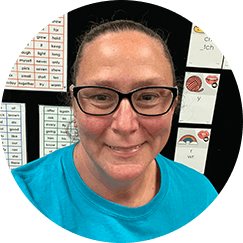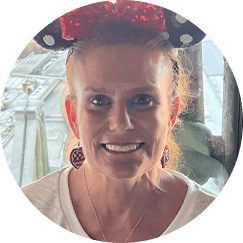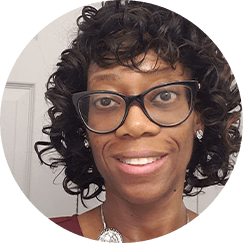Teacher appreciation week is quickly approaching! As you solidify your plans to appreciate teachers in your school/district, we’d like to begin our celebration by helping educators around the world feel heard. Within this blog you will find information straight from the source as to the challenges educators face/have faced, the challenges they’ve witnessed that their students face, and the strategies they’ve adopted to become even better teachers moving forward.
Introducing Our Panel of Educators
Before sharing some of the crucial information that may help you make positive strides in your school/district, we’d like to provide you with more information about the experienced educators we interviewed.
 Verónica E Schmidt-Gómez acts as the District Resource Teacher for Hillsborough County Public Schools’ Dual Language Immersion Program. Located in west central Florida, Verónica teaches grades 6-8 and has taught a myriad of subjects including Spanish for Spanish Speakers I and II, Beginning Spanish, Spanish I, Dual Language World History, Dual Language Civics, and Dual Language United States History.
Verónica E Schmidt-Gómez acts as the District Resource Teacher for Hillsborough County Public Schools’ Dual Language Immersion Program. Located in west central Florida, Verónica teaches grades 6-8 and has taught a myriad of subjects including Spanish for Spanish Speakers I and II, Beginning Spanish, Spanish I, Dual Language World History, Dual Language Civics, and Dual Language United States History.
 Olivia (Livie) Dillahay works as an ESE Teacher for the Manatee County School District, a district comprised of over 50,000 students and 7,000 employees in Manatee County, Florida. Serving students from Kindergarten through the fifth grade in all subjects, Dillahay takes pride in providing the tools students need to become lifelong learners.
Olivia (Livie) Dillahay works as an ESE Teacher for the Manatee County School District, a district comprised of over 50,000 students and 7,000 employees in Manatee County, Florida. Serving students from Kindergarten through the fifth grade in all subjects, Dillahay takes pride in providing the tools students need to become lifelong learners.
 Tomi Kaye Simpson is an elementary school teacher that prides herself on giving her first-grade students the tools they need to succeed. As an employee of the Mount Holly Township School District located in Burlington County, New Jersey, Simpson is a proactive educator that delivers elementary education to prepare students for the next step on their educational journey.
Tomi Kaye Simpson is an elementary school teacher that prides herself on giving her first-grade students the tools they need to succeed. As an employee of the Mount Holly Township School District located in Burlington County, New Jersey, Simpson is a proactive educator that delivers elementary education to prepare students for the next step on their educational journey.
 Juanice McLaurin is a proud Kindergarten teacher for Crosswell Drive Elementary School, a school committed to the development of world-class skills, life characteristics, and career readiness. Covering all fundamental Kindergarten skills, McLaurin takes pride in providing an environment that makes each student feel loved, safe, and encouraged.
Juanice McLaurin is a proud Kindergarten teacher for Crosswell Drive Elementary School, a school committed to the development of world-class skills, life characteristics, and career readiness. Covering all fundamental Kindergarten skills, McLaurin takes pride in providing an environment that makes each student feel loved, safe, and encouraged.
Real-Life Educators With Real-Life Challenges
Now that you’ve become familiar with the diverse group of teachers we’ve interviewed, it’s time to dig into their responses!
Q: What unique challenges do you face as a teacher?
A: “As a teacher in a school with a high Spanish-speaking, English Learner population, my greatest challenge was ensuring that students received a quality education that embraced their native language and English.” – Verónica E Schmidt-Gómez, District Resource Teacher
“My students come with a variety of complex learning and behavioral needs. It is often very difficult to differentiate instruction and independent tasks for multiple grade levels with students at many levels even within that grade level.” – Olivia (Livie) Dillahay, ESE Teacher
“One challenge that I think we, as teachers, face is reaching a wide range of students with varying abilities and interests. It can be difficult, at times, to keep such a diverse group of kids engaged and on task.” – Tomi Kaye Simpson, First Grade Teacher
“Making sure that each child is safe and experiences growth from the beginning of the year until the last day of school are two challenges.” – Juanice McLaurin, Kindergarten Teacher
Facing Challenges Head-On With Students
Teachers may face a plethora of varying challenges, but they aren't the only ones. Students, too, face challenges in the classroom, affecting their teachers and fellow classmates. Let’s take a look at the issues students face in the classrooms led by our panel of educators, as you will find that they are quite different.
Q: What unique challenges do your students face?
A: “We have a large monolingual Spanish population in Tampa that registers at all grade levels. I believe each student deserves to receive the best instructional services and methodologies to help them acquire academic English at whatever grade level.” – Verónica E Schmidt-Gómez, District Resource Teacher
“They often struggle the most with reading and phonics, which becomes a hindrance for them in all other academic areas as well. At times, these frustrations can also present as behavioral challenges.” – Olivia (Livie) Dillahay, ESE Teacher
“Although I teach first grade, I have seen firsthand how social media can negatively affect my students. The curriculum is also much more rigorous than it was when I was in school.” – Tomi Kaye Simpson, First Grade Teacher
“My students have a desire and eagerness to learn; they are very excited about school, but face some challenges as well. They may, at times, feel a little overwhelmed with what they have to learn and meeting promotion requirements.” – Juanice McLaurin, Kindergarten Teacher
Resources to Help Educators Achieve Success
Whether educators are working to address the aforementioned challenges, or they are just in need of a solution that can make their days easier, teachers often rely on trusted solutions to keep things running smoothly. Take a look at the tools our panel of educators use to get ahead in their classrooms.
Q: What resources or strategies do you rely on to make your teaching more effective?
A: “I used a Dual Language instructional model where students received ongoing academic instruction in both English and Spanish. Upon transitioning from one lesson (day) to the next, and in my case, one language to the next, I used an instructional strategy called Bridging. This is where students were given the opportunity to make a cross-linguistic analysis between English and Spanish vocabulary, or where I provided activities for them to transfer language and, thus, increase comprehension. I also made sure to incorporate the four modes of communication: writing, reading, speaking, and listening.” – Verónica E Schmidt-Gómez, District Resource Teacher
“Due to the significant gaps in the learning levels of my students, I rely on the Learning A-Z products to assign high-quality content to them that allows them academic success at their level. This builds confidence and independence often leading to academic success beyond my classroom walls as well. I also utilize the Learning A-Z products in my small groups. When I have students who are able to navigate a computer well, we use the Raz-Kids books in our small reading groups. This allows the students to mark up a text as well as provides me opportunities to have students locate evidence within a text to deepen understanding and develop comprehension skills.” – Olivia (Livie) Dillahay, ESE Teacher
“I cannot even begin to express how instrumental programs such as Writing A-Z and Reading A-Z are in helping me reinforce specific concepts [with] my students. I also do A LOT of modeling, which enables the students to gain a clear understanding of what I am teaching.” – Tomi Kaye Simpson, First Grade Teacher
“Technology is a key component of my lessons. Sometimes my students don't have the exposure or experience to understand a concept. I use resources online to help explain and expound on a particular lesson. We [also] take virtual field trips, read books, look at pictures/videos from different places, and research topics for more information and understanding.” – Juanice McLaurin, Kindergarten Teacher
Making Learning Feel More Like Fun
As an educator, student engagement is an extremely important aspect of academic success. To aid with this, we asked our panel of educators what they’ve found to be effective when it comes to keeping students excited and motivated to learn. Here's what we found:
“We use a wide variety of hands-on learning materials to make learning more concrete, and we recently had an interactive board placed in our classroom. This has made sharing content and texts easier with the students and allows them to utilize tools to locate text evidence and build comprehension skills in whole group and small group settings.” – Olivia (Livie) Dillahay, ESE Teacher
“I am constantly moving and interacting with my students. I love finding new ways to make learning fun and exciting” – Tomi Kaye Simpson, First Grade Teacher
“I teach kindergarten, so we sing and have movement with some of our lessons. My students love these activities because they are learning and moving at the same time. They [also] like to share their experiences and talk with their friends so, as much as possible, I give them an opportunity to relate what I am teaching to their own experiences. When they share with a friend what they have learned or if they can explain a concept, then you know they understand and students sometimes learn better from a friend.” – Juanice McLaurin, Kindergarten Teacher
Insight Into the Teacher Experience
Though it can be easy to think you have a theoretical understanding of the teacher experience, there are still some things that may slip through the cracks. We asked our panel of educators what they wish others knew about their experience as an educator, and it was extremely telling.
Q: What do you wish more people knew about you or about teachers in general?
A: “I wish people understood that teachers wear many hats and that teaching isn’t easy. We must make accommodations and modifications to our lesson plans to meet the needs of all students by law or otherwise.” – Verónica E Schmidt-Gómez, District Resource Teacher
“There is a story about a little boy walking along the beach throwing back starfish stranded by the outgoing tide. An older man asks him why he bothers to do that as he can’t possibly help every starfish that has washed up. The little boys respond “It matters to that one” as he gently tosses one starfish back into the ocean. That is what teachers do. We take those little faces (or sometimes not so little faces depending on the grade you teach) and we push them to be their best. We challenge them to do more than they thought they were capable of doing. We believe in them until they learn to believe in themselves because we know it “matters to that one” for each child walking through the door of our classroom.” – Olivia (Livie) Dillahay, ESE Teacher
“I wish people knew how much goes into teaching! I literally eat, sleep, and breathe teaching! Even when I am on vacation, I am constantly thinking of ways I can improve my teaching or make a lesson more engaging. Also, as my husband can attest, I also spend most of my paycheck on my students and classroom!” – Tomi Kaye Simpson, First Grade Teacher
“Teaching can be challenging at times, but it is a very rewarding career. We don't stop working when we leave the classroom, we are always thinking about ways that we can be better teachers for our students. Each year we have an opportunity to make a positive impact on each student that we come in contact with. We never know who we are teaching and encouraging; the next doctor to find a medical breakthrough, pharmacists, nurses, lab technicians, future presidents, governors, mayors, teachers, principals, superintendents, law enforcement, military personnel, lawyers, athletes, mathematician, scientists, engineers, artists, bakers, architects, beauticians, barbers, entertainers, entrepreneurs, etc... What we do matters and has a lasting impression for years to come.” – Juanice McLaurin, Kindergarten Teacher
Information For Teachers, By Teachers
We hope you have found this information useful in terms of creating an action plan to cater to the challenges your teachers may also be facing in their classrooms/districts. As Teacher Appreciation Week draws nearer, try to keep these challenges in mind to provide an environment that is as conducive as possible to learning.
Explore Our PreK-6 Education Solutions
With a variety of resources to make teaching easier and learning more fun,
you can save time, be more effective, and watch your students' literacy soar!


